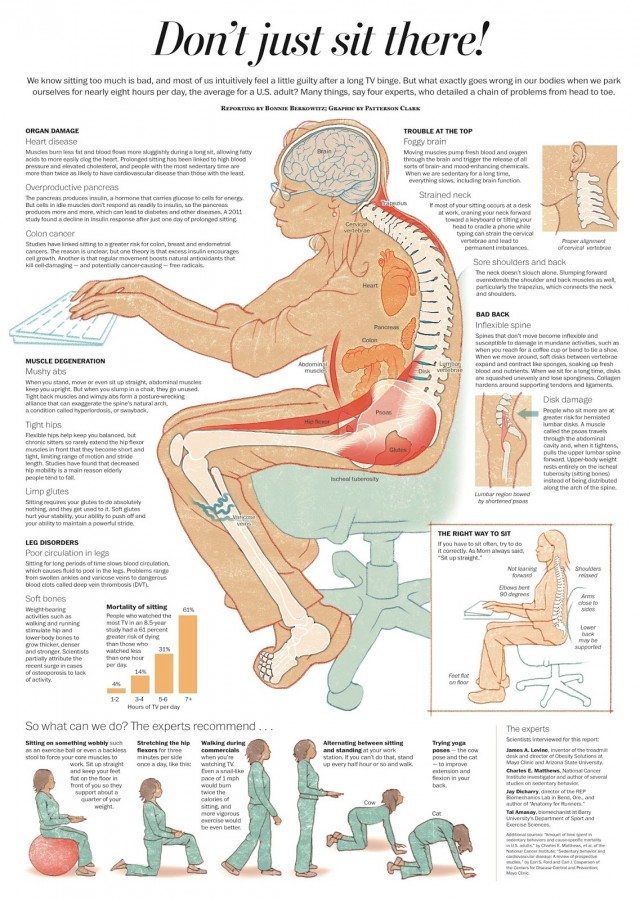
Today, we live in a world where modern machines do much of our work for us, which greatly eliminates the need for manual labor. Not to mention, over 34 million Americans have office or sales jobs, forcing them to remain sedentary for eight or more hours a day.
According to a report published in Annals of Internal Medicine, the average person spends more than half of his or her waking hours in an inactive state (sitting at a computer, watching TV, commuting to and from work, etc).
While technology brings with it obvious benefits, such as getting more done in less time, consolidating our efforts, and connecting us to others at lightning speeds, it has many drawbacks, as well.
Sitting down for prolonged periods of time can cause problems such as chronic back pain, poor posture, and even potentially deadly diseases such as diabetes, heart disease, and obesity.
If you spend a lot of time sitting down for your job, take a look at the specifics of how this can negatively impact your health, according to four experts in the industry:
Brain, Neck, And Shoulder Issues
Moving our bodies means more blood and oxygen flowing throughout the brain, which helps us maintain clarity and keeps our minds sharp. However, by sitting for long periods of time, this slows the flow of oxygen and blood to our brains, inhibiting our ability to think clearly.
Also, slumping forward at work to stare at a computer screen puts tremendous strain on the neck, particularly the cervical vertebrae, which connects the spine to your head. Poor posture also damages the back and shoulder muscles, as they become overextended due to leaning over a keyboard for long periods of time.
Back Problems
One of the most apparent problems occurs for most people in their backs, as bad posture contributes greatly to back pain, inflexible spines, and disk damage. Moving around causes soft disks between vertebrae in the spine to expand and contract, allowing blood and nutrients in. By sitting too long, the disks become uneven and compact, even causing collagen to build up around tendons and ligaments.
Also, herniated lumbar disks occur more frequently in people who spend prolonged periods of time in front of a computer.
Muscle Degeneration
Sitting doesn’t require the use of your ab muscles, and if they go unused for too long, this can actually cause you to develop what’s called swayback, or the unnatural overextension of the spine’s natural arch. Plus, sitting too long decreases overall flexibility, particularly in the hips and back. Flexible hips aid in balancing the body, but by sitting too long, the hip flexor muscles become short and tense.
The glute muscles also become soft after prolonged periods of disuse, and this hinders your ability to take long strides and keep the body stable.
Deterioration of Organs
Remaining seated for long periods of time can cause heart disease, cardiovascular disease, and colon cancer. In short, these problems are caused by the overproduction of insulin due to inactivity, and sluggish blood flow to the organs. Regular movement helps kill cancer-causing cells, boosting antioxidants that eliminate these free radicals from taking over the body.
Overproduction of insulin also causes weight gain, which contributes to diabetes and obesity.
Leg Disorders
Obviously, sitting too long will hinder circulation in the legs. This causes blood to pool around the ankles, which then results in swollen ankles, varicose veins, and even harmful blood clots. Another more subtle issue caused by prolonged sitting is that bones become weaker and less dense. Regular activity, such as running or walking, helps keep bones strong and thick. This might explain why so many elderly people today have osteoporosis, as society becomes more and more sedentary.
According to the study, people who watched the most TV over the span of 8.5 years had a 61% greater risk of dying a premature death compared to those who watched less than one hour per day.
SO, HOW CAN WE COMBAT THIS GROWING EPIDEMIC OF INACTIVITY?

First of all, if you DO have to sit for long periods of time for work or other purposes, make sure you sit up straight and avoid slouching or leaning over your keyboard. If you have to, buy an exercise ball, which forces your ab muscles to work and will naturally keep your body straight. You can also use a backless stool if you want something a little more stable than an exercise ball.
Secondly, make sure to get up regularly to stretch. How often should you do this? At least once every thirty minutes, according to experts. Get up and walk around your office for a few minutes as well, which will keep the blood flowing and allow your brain and muscles to function optimally.
Thirdly, yoga can help immensely with keeping the muscles flexible and allowing the mind to relax and decompress from the work day. You can also buy a standing work desk, which will force you to do your work in an upright position. This helps blood and oxygen flow more freely through the body, reducing the risk of blood clots and other dangerous health problems.
source www.powerofpositivity.com
0 comments:
Post a Comment